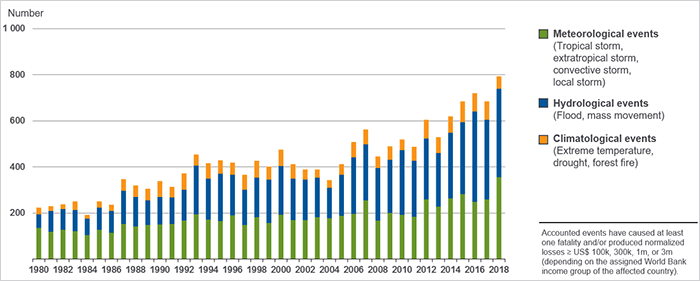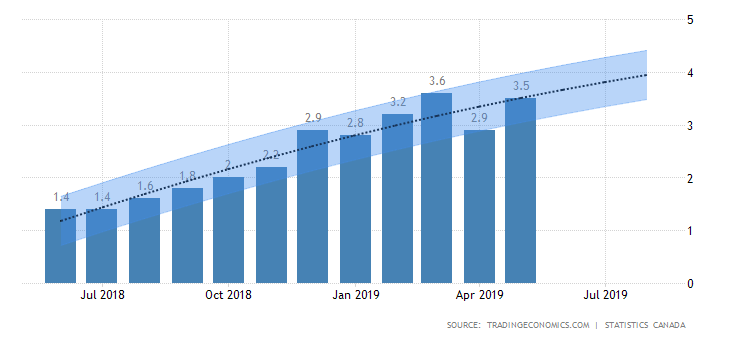GROWING SEASON IMPACTSIntroductionThe start of the growing season in the Northern Hemisphere has met with a difficult start. Following established trends of intensification going back almost forty years, there seems to be no end in sight. Trade disputes and tariffs are making a difficult situation worse and if conditions continue it will likely result in across the board food price increase. To top what has been previously mentioned is the possible protein shortage due to disease in animal stocks worldwide for pork and poultry. Food index prices in Canada remain almost a percentage point at 3.5% above the national inflation rate. Extreme weatherAs a follower of our content, you are no doubt aware of this graphic which details the rise in extreme weather since 1980. Taken altogether, there has been a four hundred percent increase in events from 1980 to 2018, with most being floods and extreme weather events. This intensification has been more noticeable in recent years which happens to correlate with a slow down in food production worldwide. The 2018/19 growing season has concluded in the Southern Hemisphere and has most notably resulted in Australia importing wheat for the first time in 12 years (Walhquist, 2019, para. 1). For the other Southern growing regions, it was a similar story with decreased food production. The Northern Hemisphere’s growing season has been negatively impacted by floods and cold weather into late spring and early summer. Major parts of the midwest, affected from flood, are still not ready for planting with estimates of 67% planted for corn over 96% last year, 40 million acres not planted (Moon, 2019, para.7). Closer to home, Albertan farmers are dealing with a loss of nearly 68% in total income, from last year to a combination of extreme weather, drought, and trade (Stephenson, 2019, para.2). TradeSince the inception of the World Trade Organization (WTO), in 1995, international trade rules govern the production, distribution and trade of commodities. The policies and conventions that have developed as a result of this activity has had the effect of increasing food insecurity, especially among developing countries (Martin & LaBorde, 2018, para. 7). Current actions by governments and economies have not resulted in a favorable setting. To add fuel to the fire is the recent trade disputes and trade actions in the form of tariffs by the U.S. President. Trump has not been one to shy away from using tariffs to achieve foreign and economic policy goals, as recently evidenced by the threat of tariffs with Mexico over migrant caravans (Pittis, 2019, para. 3) or in recent trade disputes with China (Mason & Lawder, 2019, para. 3). The use of tariffs has a rippling negative effect on the world economy and food insecurity situation (Martin & LaBorde, 2018, para.2). Closer to home, the countries where we source our food is growing in price and decreased unavailability due to regulation. Under the Trump administration, border protection has begun to enforce laws which has inhibited the continuous flow of produce over the borders. As a result, food can become spoiled due to the time it takes to cross the border (Border crisis may soon impact fruit, vegetable prices, experts say, 2019, para.10). Close to homeIn May, U.S. and Canada governments ended their trade disputes over steel and aluminium (Tunney & Simpson, ,2019, para.3). The year long dispute not only affected steel and aluminum but food products as well. Despite this trade dispute other disputes like the U.S. and China trade war has to potential to decrease Canadian Economy by 0.08% resulting in job losses of 150,000 (Tencer, 2019, paras. 2-3). The current Canadian Food Price Index May stands at 3.5% over last year, an increase in 6% from 2.9% in April. The categories which saw the most increase is meats, fruits, and vegetables. Most meats were on par with the current rate but fish was elevated at 6.6%. Oranges and apples were at 13.2% and 22.1%, respectively. Fresh vegetables stood generally at 17.8%, with potatoes at 16.4%, tomatoes at 14.0%, Lettuce at 12.2%, and interestingly enough ‘other fresh vegetables’ at a whopping 17.8% (Statistics Canada, 2019, Table 18-10-0004-03). ConclusionThe overall picture for food security is impacted by manmade and natural events. Developing countries are dealing with intensifying extreme weather and the word, “famine,” is creeping into the lexicon used by the Food and Agriculture Organization of the United Nations. Famine in the 1980’s were remedied as a result of a more efficient distribution of resources but extreme weather increases and food systems failures have reversed this trend, with some developing countries at near famine standards. I have used this hiking analogy where the fastest a party hikes is at its slowest member. As a people, we progress at the pace of those in our vulnerable populations. In order to meet the rising need and to safeguard our future we need to consider alternative ways to the current conventions. It is not known whether the increasing volatility within our climate will stabilize any time soon and it is important to our basic need that we adapt to these extreme conditions. Part of the solution is to the old ways and will be the next topic for the blog. ReferencesBorder crisis may soon impact fruit, vegetable prices, experts say. (2019, April 25). Retrieved from http://www.fox32chicago.com/news/dont-miss/border-crisis-may-soon-impact-fruit-vegetable-prices-experts-say
Martin, W. & LaBorde, D. (2018, May 30). How trade wars threaten food security. Food Policy Research Institute. Retrieved from http://www.ifpri.org/blog/how-trade-wars-threaten-food-security Mason, J. & Lawder, D. (2019, May 9). First day of U.S.-China trade talk ends; Trump's tariff hike set to take effect. Reuters. Retrieved from https://www.reuters.com/article/us-usa-trade-china/first-day-of-u-s-china-trade-talks-ends-trumps-tariff-hike-set-to-take-effect-idUSKCN1SF2BF Moon, E. (2019, June 6). ‘The fields are washing away:’ Midwest flooding is wreaking havoc on farmers. Pacific Standard. Retrieved from https://psmag.com/environment/the-fields-are-washing-away-midwest-flooding-is-wreaking-havoc-on-farmers Pittis, D. (2019, June 1). Tariff threat against Mexico confirms a deal's not a deal with Trump: Don Pittis. Canadian Broadcasting Corporation. Retrieved from https://www.cbc.ca/news/business/trump-mexico-tariffs-1.5157253 Stephenson, A. (2019, May 30). 'An absolutely brutal year': Alberta farm incomes plummet 70 per cent in 2018. Calgary Herald. Retrieved from https://calgaryherald.com/business/local-business/an-absolutely-brutal-year-alberta-farm-incomes-plummet-70-per-cent-in-2018 Tencer, D. (2019, May 14) U.S.-China Trade War Threatens To Shrink Canada's Economy By Enough To Kill 150,000 Jobs: BMO. Huffington Post. Retrieved from https://www.huffingtonpost.ca/2019/05/14/us-china-trade-war-canada-economy_a_23726056/ Tunney, C. & Simpson, K. (2019, May 17). Canada, U.S. reach deal to lift steel and aluminum tariffs within 2 days. Canadian Broadcasting Corporation. Retrieved from https://www.cbc.ca/news/politics/tariff-steel-aluminum-deal-canada-trump-1.5140031 Walhquist, C. (2019, May 15). Australia to import wheat for first time in 12 years as drought eats into grain production. The Guardian. Retrieved from https://www.theguardian.com/australia-news/2019/may/15/australia-to-import-wheat-for-first-time-in-12-years-as-drought-eats-into-grain-production
0 Comments
|
AuthorWrite something about yourself. No need to be fancy, just an overview. Archives
March 2022
Categories |



 RSS Feed
RSS Feed